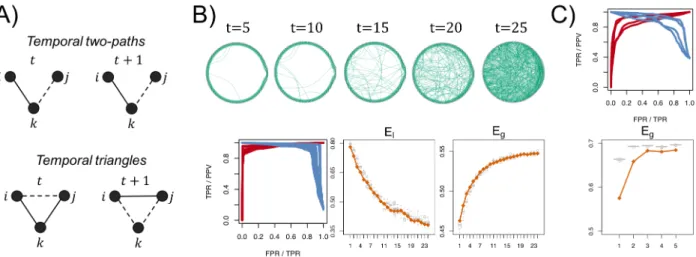HAL Id: hal-01967589
https://hal.inria.fr/hal-01967589
Submitted on 31 Dec 2018
HAL is a multi-disciplinary open access archive for the deposit and dissemination of sci-entific research documents, whether they are pub-lished or not. The documents may come from teaching and research institutions in France or abroad, or from public or private research centers.
L’archive ouverte pluridisciplinaire HAL, est destinée au dépôt et à la diffusion de documents scientifiques de niveau recherche, publiés ou non, émanant des établissements d’enseignement et de recherche français ou étrangers, des laboratoires publics ou privés.
Temporal metrics for exponential random graph models
of time-evolving networks
Catalina Obando Forero, Fabrizio de Vico Fallani
To cite this version:
Catalina Obando Forero, Fabrizio de Vico Fallani. Temporal metrics for exponential random graph models of time-evolving networks. NetSci 2018 - International School and Conference in Complex Science, Jun 2018, Paris, France. �hal-01967589�
Temporal metrics for exponential random graph models of time-evolving networks
Catalina Obando1,2 and Fabrizio De Vico Fallani1,2
1. Inria Paris, Aramis project-team, Paris, France
2. CNRS UMR-7225, Sorbonne Universites, UPMC Univ Paris 06, Inserm, Institut du cerveau et la moelle (ICM) - Hôpital Pitié-Salpêtrière, Paris, France.
Recently we have seen a growing interest for temporal networks as they are a more accurate representation of real life complex systems [1]. Temporal networks estimated from experimentally obtained data, represent one instance of a larger number of realizations with similar dynamic topology. A modeling approach is therefore needed to support statistical inference.
In this work, we adopted a statistical model based on temporal exponential random graphs (TERGM) to reproduce time-evolving networks [2]. TERGMs are composed by different local (temporal) graph metrics whereas the parameters weight the respective contribution in explaining the observed network. Here, we define temporal triangles (𝑇") and 2-paths (𝑃") (Fig.1.A) as follows:
𝑇" 𝑁", 𝑁"'( = 𝑁*+"𝑁,+"𝑁*,"'(
*,+ 1)
𝑃"(𝑁", 𝑁"'() = *,+𝑁*+" 1 − 𝑁*," 𝑁,+"'((1 − 𝑁*,"'() 2)
where N is the adjacency matrix corresponding to the network. We first validated this approach in synthetic networks generated by using a correlated version of the Watts-Strogatz model, where each temporal network is generated from the previous one by rewiring links with an increasing probability 𝑝, starting from a lattice. Results showed that the model including temporal two-paths and triangles statistically reproduced the main properties of synthetic networks assessed by link prediction capacity and global- and local-efficiency (Figure 1.B).
We finally applied our approach on the Facebook temporal network [3], and we show that only by including temporal two-paths our TERGM is able to generate a good fit and to statistically reproduce the evolution of the global-efficiency of the network (Fig.1.C).
These preliminary results support the development of alternative tools to model the evolution of complex networks based on temporal connection rules, with applications ranging from social science to neuroscience.
[1] Holme, et al Physics report, 2012
[2] Leifeld et al, Journal of Statistical Software, 2017
[3] Madan et al, IEEE Pervasive Computing, 2012
Figure 1: (A) Graphical representation of temporal two-paths and temporal triangles. (B) First row: sample of 25 synthetic networks produced with Watts-Strogatz model adding correlation between each time step. Second row: i) the receiver operating characteristic (ROC) curve of the out-of-sample prediction of network ties and the precision-recall (PR) curve of the prediction shows the goodness-of-fit of the model; ii) local- and global-efficiency of the synthetic networks (solid orange curve) and of simulated networks by the TERGM (grey boxplots). (C) ROC and PR average area curves were larger for the model only including 𝑇34 (𝑅𝑂𝐶 = 0.88, 𝑃𝑅 = 0.85)
than models including 𝑇34, 𝑇" (𝑅𝑂𝐶 = 0.87, 𝑃𝑅 = 0.85) and only 𝑇" (𝑅𝑂𝐶 = 0.79, 𝑃𝑅 = 0.73). Facebook temporal networks are
